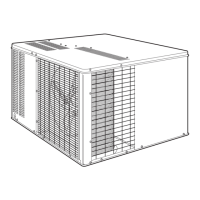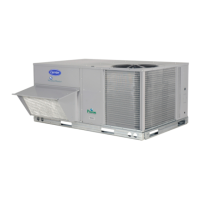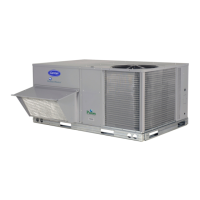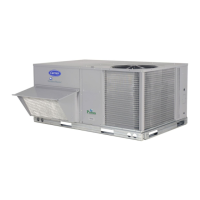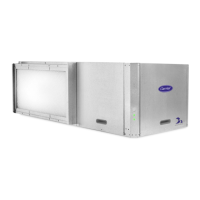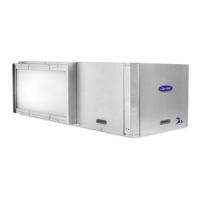
Do you have a question about the Carrier 50HQ Series and is the answer not in the manual?
Installation and servicing can be hazardous. Use trained personnel and follow safety codes.
Turn off main power before service to prevent electrical shock.
Unpack, inspect, and verify system requirements before installation.
Consult codes, ensure adequate water supply, provide service space, and ensure clearances.
Install supply air flange, connect ductwork, consider duct design factors.
Size ducts for airflow, avoid abrupt changes, insulate ducts in unconditioned spaces.
Connect water supply and return lines, use flexible hose, ensure proper flow.
Instructions for installing suspension kit using bolts and threaded rod.
Comply with codes, ensure correct voltage, install branch circuit disconnect.
Set fan motor for high, medium, or low speed operation using selector block.
Diagrams illustrating water piping for 50VQ and 50HQ units.
Connect condensate drain lines, install trap, and ensure proper drainage.
Consider design water flow rates and ensure correct water temperature entering the unit.
Ensure filter is in place, set thermostat, check refrigerant charge.
Information on pressure relief valve and overload protection.
Unit is factory charged. Recharging requires weighing total charge and using charts.
Controls prevent operation if water temperature approaches freezing.
Diagrams for refrigerant and water flow in heating/cooling cycles.
Steps for checking and adjusting refrigerant charge using charts.
Charging charts for specific 50HQ, VQ models.
Check charts for specific 50HQ, VQ models during heating cycle.
Charging charts for specific 50HQ, VQ models.
Check charts for specific 50HQ, VQ models during heating cycle.
Steps for using the Chargemaster device for system charging.
Table listing compressor models and oil recharge amounts.
Safety precautions and steps for removing the compressor.
Procedures for removing the indoor blower assembly for 50VQ and 50HQ units.
Steps for removing the indoor fan wheel and motor.
Instructions for cleaning the coil, condensate pan, and drain.
Lists causes like blown fuses, wiring issues, low voltage, transformer, or thermostat problems.
Covers low voltage, wiring, high-pressure controls, defective capacitor, seized, or overloaded compressor.
Explains issues related to low water temperature cutout and switches.
Addresses unit undersizing, air leaks, thermostat issues, airflow, and refrigerant charge.
Discusses compressor contact with cabinet, shipping bolts, broken valves, or loose discharge tubes.
Covers blower hitting casing, bent blower, loose wheel, or defective bearings.

